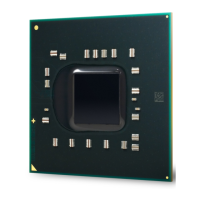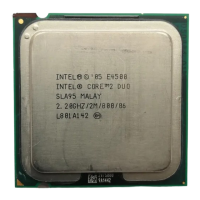Datasheet 93
Package Mechanical Specifications and Pin Information
4.3 Alphabetical Signals Reference
Table 19. Signal Description (Sheet 1 of 8)
Name Type Description
A[35:3]#
Input/
Output
A[35:3]# (Address) define a 2
36
-byte physical memory address
space. In sub-phase 1 of the address phase, these pins transmit the
address of a transaction. In sub-phase 2, these pins transmit
transaction type information. These signals must connect the
appropriate pins of both agents on the processor FSB. A[35:3]# are
source-synchronous signals and are latched into the receiving
buffers by ADSTB[1:0]#. Address signals are used as straps, which
are sampled before RESET# is deasserted.
A20M# Input
If A20M# (Address-20 Mask) is asserted, the processor masks
physical address bit 20 (A20#) before looking up a line in any
internal cache and before driving a read/write transaction on the
bus. Asserting A20M# emulates the 8086 processor's address
wrap-around at the 1-MB boundary. Assertion of A20M# is only
supported in real mode.
A20M# is an asynchronous signal. However, to ensure recognition
of this signal following an input/output write instruction, it must be
valid along with the TRDY# assertion of the corresponding input/
output Write bus transaction.
ADS#
Input/
Output
ADS# (Address Strobe) is asserted to indicate the validity of the
transaction address on the A[35:3]# and REQ[4:0]# pins. All bus
agents observe the ADS# activation to begin parity checking,
protocol checking, address decode, internal snoop, or deferred
reply ID match operations associated with the new transaction.
ADSTB[1:0]#
Input/
Output
Address strobes are used to latch A[35:3]# and REQ[4:0]# on their
rising and falling edges. Strobes are associated with signals as
shown below.
BCLK[1:0] Input
The differential pair BCLK (Bus Clock) determines the FSB
frequency. All FSB agents must receive these signals to drive their
outputs and latch their inputs.
All external timing parameters are specified with respect to the
rising edge of BCLK0 crossing V
CROSS
.
BNR#
Input/
Output
BNR# (Block Next Request) is used to assert a bus stall by any bus
agent who is unable to accept new bus transactions. During a bus
stall, the current bus owner cannot issue any new transactions.
BPM[2:1]#
BPM[3,0]#
Output
Input/
Output
BPM[3:0]# (Breakpoint Monitor) are breakpoint and performance
monitor signals. They are outputs from the processor that indicate
the status of breakpoints and programmable counters used for
monitoring processor performance. BPM[3:0]# should connect the
appropriate pins of all processor FSB agents.This includes debug or
performance monitoring tools.
Signals Associated Strobe
REQ[4:0]#, A[16:3]# ADSTB[0]#
A[35:17]# ADSTB[1]#

